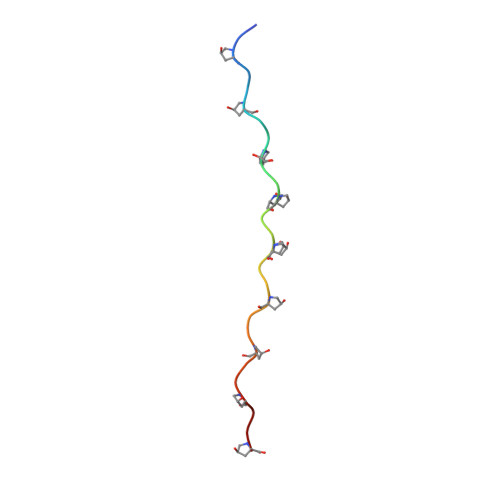Unique Conformation in a Natural Interruption Sequence of Type XIX Collagen Revealed by Its High-Resolution Crystal Structure.
Xu, T., Zhou, C.Z., Xiao, J., Liu, J.(2018) Biochemistry 57: 1087-1095
- PubMed: 29376320
- DOI: https://doi.org/10.1021/acs.biochem.7b01010
- Primary Citation of Related Structures:
5Y45, 5Y46 - PubMed Abstract:
Naturally occurring interruptions in nonfibrillar collagen play key roles in molecular flexibility, collagen degradation, and ligand binding. The structural feature of the interruption sequences and the molecular basis for their functions have not been well studied. Here, we focused on a G5G type natural interruption sequence G-POALO-G from human type XIX collagen, a homotrimer collagen, as this sequence possesses distinct properties compared with those of a pathological similar Gly mutation sequence in collagen mimic peptides. We determined the crystal structures of the host-guest peptide (GPO) 3 -GPOALO-(GPO) 4 to 1.03 Å resolution in two crystal forms. In these structures, the interruption zone brings localized disruptions to the triple helix and introduces a light 6-8° bend with the same directional preference to the whole molecule, which may correspond structurally to the first physiological kink site in type XIX collagen. Furthermore, at the G5G interruption site, the presence of Ala and Leu residues, both with free N-H groups, allows the formation of more direct and water-mediated interchain hydrogen bonds than in the related Gly → Ala structure. These could partly explain the difference in thermal stability between the different interruptions. In addition, our structures provide a detailed view of the dynamic property of such an interrupted zone with respect to hydrogen bonding topology, torsion angles, and helical parameters. Our results, for the first time, also identified the binding of zinc to the end of the triple helix. These findings will shed light on how the interruption sequence influences the conformation of the collagen molecule and provide a structural basis for further functional studies.
- School of Life Sciences, University of Science and Technology of China , Hefei 230026, China.
Organizational Affiliation:

















